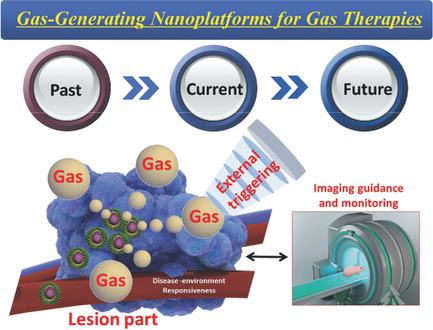当前位置:
X-MOL 学术
›
Adv. Mater.
›
论文详情
Our official English website, www.x-mol.net, welcomes your feedback! (Note: you will need to create a separate account there.)
Gas‐Generating Nanoplatforms: Material Chemistry, Multifunctionality, and Gas Therapy
Advanced Materials ( IF 29.4 ) Pub Date : 2018-07-31 , DOI: 10.1002/adma.201801964 Luodan Yu 1, 2 , Ping Hu 1 , Yu Chen 1
Advanced Materials ( IF 29.4 ) Pub Date : 2018-07-31 , DOI: 10.1002/adma.201801964 Luodan Yu 1, 2 , Ping Hu 1 , Yu Chen 1
Affiliation

|
The fast advances of theranostic nanomedicine enable the rational design and construction of diverse functional nanoplatforms for versatile biomedical applications, among which gas‐generating nanoplatforms (GGNs) have emerged very recently as unique theranostic nanoplatforms for broad gas therapies. Here, the recent developments of the rational design and chemical construction of versatile GGNs for efficient gas therapies by either exogenous physical triggers or endogenous disease‐environment responsiveness are reviewed. These gases involve some therapeutic gases that can directly change disease status, such as oxygen (O2), nitric oxide (NO), carbon monoxide (CO), hydrogen (H2), hydrogen sulfide (H2S) and sulfur dioxide (SO2), and other gases such as carbon dioxide (CO2), dl‐menthol (DLM), and gaseous perfluorocarbon (PFC) for supplementary assistance of the theranostic process. Abundant nanocarriers have been adopted for gas delivery into lesions, including poly(d,l‐lactic‐co‐glycolic acid), micelles, silica/mesoporous silica, organosilica, MnO2, graphene, Bi2Se3, upconversion nanoparticles, CaCO3, etc. Especially, these GGNs have been successfully developed for versatile biomedical applications, including diagnostic imaging and therapeutic use. The biosafety issue, challenges faced, and future developments on the rational construction of GGNs are also discussed for further promotion of their clinical translation to benefit patients.
中文翻译:

产气纳米平台:材料化学,多功能性和气体疗法
纳米治疗药物的快速发展使得能够合理设计和构建适用于多种生物医学应用的功能多样的纳米平台,其中,气体生成纳米平台(GGN)近年来已成为广泛的气体疗法的独特的纳米治疗平台。在此,对通过外源性物理触发或内源性疾病-环境响应性进行有效气体治疗的通用GGN的合理设计和化学结构的最新进展进行了综述。这些气体涉及一些可以直接改变疾病状态的治疗气体,例如氧气(O 2),一氧化氮(NO),一氧化碳(CO),氢气(H 2),硫化氢(H 2 S)和二氧化硫(O SO 2),以及其它气体,例如二氧化碳(CO 2),DL l-薄荷醇(DLM),和全氟化碳气体(PFC)用于治疗诊断过程的补充援助。丰富纳米载体已被采纳用于气体输送到病变,包括聚(d,升-lactic-共-glycolic酸),胶束,二氧化硅/孔二氧化硅,有机二氧化硅,的MnO 2,石墨烯,铋2硒3,上转换纳米颗粒,碳酸钙3尤其是,这些GGN已成功开发用于多种生物医学应用,包括诊断成像和治疗用途。还讨论了生物安全性问题,面临的挑战以及GGNs合理构建的未来发展,以进一步促进其GGNs的临床翻译,以使患者受益。
更新日期:2018-07-31
中文翻译:

产气纳米平台:材料化学,多功能性和气体疗法
纳米治疗药物的快速发展使得能够合理设计和构建适用于多种生物医学应用的功能多样的纳米平台,其中,气体生成纳米平台(GGN)近年来已成为广泛的气体疗法的独特的纳米治疗平台。在此,对通过外源性物理触发或内源性疾病-环境响应性进行有效气体治疗的通用GGN的合理设计和化学结构的最新进展进行了综述。这些气体涉及一些可以直接改变疾病状态的治疗气体,例如氧气(O 2),一氧化氮(NO),一氧化碳(CO),氢气(H 2),硫化氢(H 2 S)和二氧化硫(O SO 2),以及其它气体,例如二氧化碳(CO 2),DL l-薄荷醇(DLM),和全氟化碳气体(PFC)用于治疗诊断过程的补充援助。丰富纳米载体已被采纳用于气体输送到病变,包括聚(d,升-lactic-共-glycolic酸),胶束,二氧化硅/孔二氧化硅,有机二氧化硅,的MnO 2,石墨烯,铋2硒3,上转换纳米颗粒,碳酸钙3尤其是,这些GGN已成功开发用于多种生物医学应用,包括诊断成像和治疗用途。还讨论了生物安全性问题,面临的挑战以及GGNs合理构建的未来发展,以进一步促进其GGNs的临床翻译,以使患者受益。



























 京公网安备 11010802027423号
京公网安备 11010802027423号